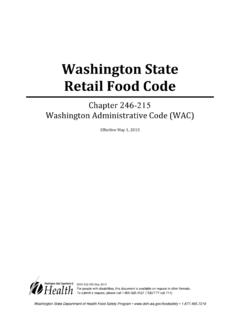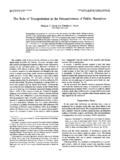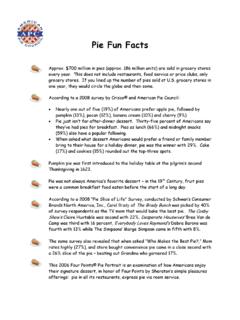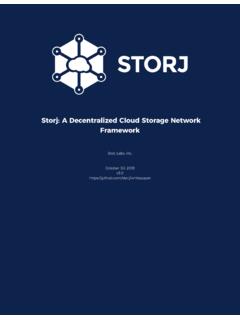Transcription of Popularity of A level subjects among university …
1 Popularity of A level subjects among UK university students Statistical Report Series no. 52 Carmen Vidal Rodeiro and Tom Sutch June 2013 Research Division Assessment Research and Development Cambridge Assessment 1 Regent Street, Cambridge, CB2 1GG 2 Contents 1. Introduction .. 3 2. Description of the data .. 4 3. Results .. 6 Individual A level subjects .. 6 A level facilitating subjects .. 29 Combinations of A level subjects .. 34 Appendix A: university subjects and degree subject areas .. 43 Appendix B: university groups .. 47 Appendix C: university acceptances by degree subject area and university mission group .. 51 Appendix D: Most popular A level subject combinations for degree subject areas .. 52 3 1. Introduction In England the principal measure of academic attainment for 18 year-old pre- university learners is the A level , a general qualification in which learners are awarded grades to reflect their attainment in each subject that they have chosen to study.
2 In recent years, over 80 different subjects have been offered at A level by the three main awarding bodies in England. Learners can decide which and how many of those subjects they wish to study depending on, for example, their career choices, their academic ability, the provision at their school/college or the advice given to them. Students aiming for university typically study three or four subjects at A level . Choosing A levels however is not straightforward as some subjects might be seen as providing better grounding for university courses than others. The aim of this statistical research report was, therefore, to investigate the proportions of students who hold each A level subject (or combinations of A level subjects ) when applying for a place at university . In particular, the research focused on: the uptake of A level subjects , and combinations of A level subjects , among university applicants and accepted applicants; a comparison of the uptake of A level subjects , and combinations of A level subjects , between university applicants, accepted applicants and the whole A level cohort; the uptake of A level subjects , and combinations of A level subjects , among accepted applicants o by university group, o by degree subject at university ; a comparison of performance in the most popular A level subjects , and in combinations of A level subjects , between accepted applicants and the whole A level cohort; the performance in the most popular A level subjects , and in the combinations of A level subjects , among accepted applicants o by university mission group, o by degree subject at university1.
3 The outcomes of this research may inform the usefulness of specific A level subjects or combinations of A level subjects as currency for university study. 1 Analyses looking at A level performance by degree subject at university have been carried out and are available upon request for each individual subject area. They are not included in this report as they would generate in excess of 30 pages of tables/graphs. 4 2. Description of the data The main source of data for the analyses carried out in this report was provided by the Universities and Colleges Admissions Service (UCAS2) and contains, for all students applying to study at a UK university during the 2010/11 application cycle and who obtained at least one A level , the following information: A level subjects studied Grades achieved in the A level subjects university mission group (accepted applicants only) subject of study at university (accepted applicants only) Applicant flag Accept flag The subject of study at university was provided as a list of 180 subject lines (using the JACS3 system).
4 These relate to the principal subject of the student s qualification aim. The subject of study was aggregated into 25 broad degree subject areas. Appendix A lists the subject lines and degree subject areas used in this research. For example, a student accepted to study for a degree in mathematics (G100) would be classified in the subject line Mathematics and the subject area Mathematical & Computer Science . Similarly, a student accepted to study for a degree in statistics (G300) would be classified in the subject line Statistics and the subject area Mathematical & Computer Science . The analyses presented in this report were carried out at degree subject area level . The higher education institutions are considered in groups through which they share ideas and resources regarding issues and procedures in the higher education sector. The groups provided by UCAS for this research are4: The Russell Group, The 1994 Group, university Alliance and The Million+ Group.
5 Appendix B shows a description of each group and provides a list of its members. It should be noted that some universities might not have joined any of the groups above and therefore would be classified as Other. Appendix C contains general information on acceptances for higher education courses in the 2010/11 application cycle by university group and subject group5. Data on the uptake of and performance in A level subjects for the full A level cohort in 2011 was obtained from the National Pupil Database (NPD). This database, compiled by the Department for Education, is a longitudinal database for all children in schools in England, linking student characteristics to school and college learning aims and attainment. The NPD holds pupil and school characteristics such as age, gender, ethnicity, level of deprivation, attendance and exclusions, matched to pupil level attainment data (Key Stage 2 to Key Stage 5 assessments and other external examinations).
6 2 UCAS cannot accept responsibility for any inferences or conclusions derived from the data by third parties. 3 The Joint Academic Classification of subjects (JACS) system is used by the Higher Education Statistics Agency (HESA) and the Universities and Colleges Admissions Service (UCAS) to classify academic subjects , especially for undergraduate degrees. 4 UCAS did not provide data at individual institution level due to confidentiality issues. 5 Source: 5 In the following sections of this report, descriptive statistics provide information on the destinations (universities and degree subject areas) of students with each A level subject and with the most popular combinations of A level subjects . 6 3. Results Individual A level subjects Uptake The tables presented in this section of the report show which individual A level subjects were most commonly held by undergraduates in UK higher education institutions in the academic year 2011/12.
7 As stated in Sections 1 and 2, the uptake of A level subjects is investigated in five university mission groups and in 25 degree subject areas. In order to simplify the presentation of the results from those analyses, degree subjects areas were grouped in five broad groups, as shown in Table 1, and five separate tables/figures were provided. Table 1: Classification of degree subject area Degree subject group Degree subject area Group 1 subjects allied to Medicine Biological Sciences Medicine & Dentistry Veterinary Science, Agriculture & related subjects Group 2 Architecture, Building and Planning Engineering Mathematics & Computer Science Physical Sciences Technologies Group 3 Business & Administrative Studies Mass Communications & Documentation Creative Arts & Design Education Social Studies Group 4 European Languages, Literature & related subjects History & Philosophical studies Law Linguistics, Classics & related subjects Non-European Languages & related subjects Group 5 Combined Arts Combined Sciences Combined Social Sciences Sciences combined with social sciences or arts Social sciences combined with arts General.
8 Other combined & unknown 7 Some of the tables in this section display a comparison of the uptake of A level subjects between university applicants, accepted applicants and the whole A level cohort. It should be noted though that some A level subjects featured in the UCAS data and not in the June 2011 extract of the NPD. Some examples of this were Divinity, Hindi, Biblical Hebrew or Islamic Studies, which students applying to university held but did not appear in the NPD. One possible explanation for this is that the coding of the subjects was different in both datasets and, for example, Biblical Hebrew, present in the UCAS data as such, appeared in the NPD under Other Classical Languages . Table 2 shows the uptake of individual A level subjects among university applicants in the 2010/11 application cycle and it compares that to the uptake of these subjects by the whole A level cohort in 2011.
9 All A level subjects present in the UCAS data were included in the table and were ordered alphabetically. Thus, Accounting, the subject presented first, was taken by of the university applicants in the 2010/11 admissions cycle. This compares with Accounting being taken by of the accepted applicants for undergraduate courses and of the A level cohort in 2011. The most popular subject among university applicants was Mathematics (around 30% of the accepted applicants held an A level in this subject ), followed by Biology, History, Chemistry and English Literature. It should be noted that the order of the subjects by their Popularity was fairly similar in all three groups of students. The percentages of students holding STEM (Science, Technology, Engineering and Mathematics) subjects at A level was higher among accepted applicants and university applicants in general than among all A level students.
10 This pattern was also similar in most humanities subjects but reversed in subjects such as Art & Design, Music, and Design & Technology. The uptake of individual A level subjects (as above) is presented, broken down by degree subject and university mission group in Table 3 and Tables 4(a) to 4(e), respectively. Table 3 shows, for example, that Mathematics was taken by of the accepted applicants to Russell Group universities, of the accepted applicants to universities in the 1994 Group, and and of the accepted applicants to universities in the university Alliance and the Million+ groups, respectively. Table 3 also shows that students accepted to Russell Group and 1994 Group universities held in higher proportions A levels in other STEM subjects ( Biology, Chemistry, Physics, Further Mathematics) and in foreign languages ( French, German, Spanish) than students accepted to universities in the university Alliance or the Million+ Group.

















